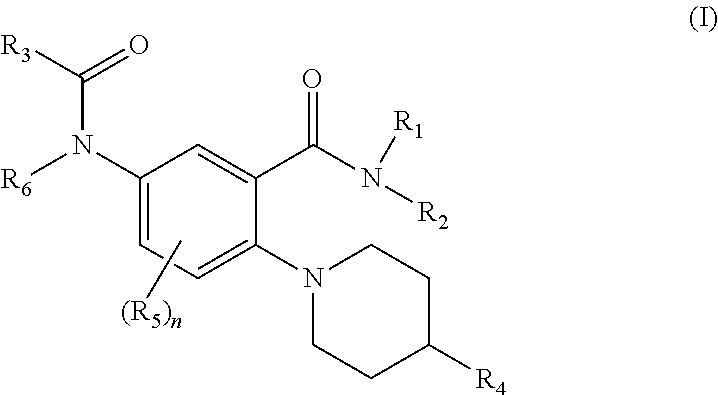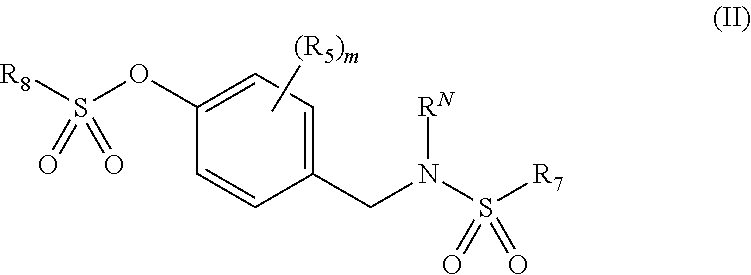Method of Treating Skin with microRNA Modulators
a technology of modulator and skin, applied in the direction of biocide, heterocyclic compound active ingredients, drug compositions, etc., can solve the problems of focusing on the role of micrornas, achieve the effects of enhancing the levels of collagen, elastin, and/or fibrillin in the skin, and improving the aesthetic appearance of skin
- Summary
- Abstract
- Description
- Claims
- Application Information
AI Technical Summary
Benefits of technology
Problems solved by technology
Method used
Image
Examples
example 1
Age-Related Expression of miR-29a & miR-29b Levels in Skin Fibroblasts
[0117]The expression of miR-29a and miR29b in young versus old skin fibroblasts was examined by qRT-PCR. The experiment was conducted using three sets of donor cells (i.e., three younger donors (age 22-28 yrs) and three older donors (age 55-66 yrs). HDFa cells were grown to about 80% confluence. Cells were lysed using Taqman MicroRNA Cells-to-Ct Kit. cDNA was prepared using miR specific primers and TaqMan MicroRNA Reverse Transcription Kit. qPCR was carried out using predesigned TaqMan MicroRNA Assays for hsa-miR-29a and hsa-miR-29b, and controls RNU6B and GAPDH, purchased from Applied Biosystems. Data summarized in Table 1 below demonstrate that there are significantly higher levels of miR-29a and miR29b in older compared to younger skin fibroblasts.
TABLE 1microRNAYoung (%)Old (%)miR-29a100350miR-29b100390
[0118]In Table 1, the data represent an average of 3 donors per age group. All values are statistically signi...
example 2
Modulation of ECM Proteins Via Suppression miR-29a and miR-29b
[0119]The ability of the specific microRNAs, miR29a and miR29b, to modulate expression of dermal matrix proteins such as collagen, fibrillin and elastin was examined using human dermal fibroblasts from a 55 year-old donor. Cells were transfected with 60 nm of either anti-miR-29a or anti-miR-29b (commercially available reagents) using siSPORT NeoFX transfection Agent (Ambion). Cells were harvested 72 hours post-transfection and the mRNA levels of collagen and fibrillin were determined by qRT-PCR and protein level of elastin was determined by ELISA. These experiments indicated that by suppressing miR-29a or miR-29b, net expression levels of collagen, fibrillin and elastin can be increased (Table 3). All values are statistically significant at p<0.05.
TABLE 2Suppression ofIncrease inIncrease inIncrease inmicroRNAmiR (%)Collagen (%)Fibrillin (%)Elastin (%)miR-29a−5813010725miR-29b−6514022056
[0120]As indicated in Table 2, miR-2...
example 3
Inhibition of miR-29a or miR-29b by Specific Compounds
[0121]Human dermal fibroblasts were grown in the absence of serum overnight, followed by treatment with 0.0005% of test compounds in the absence of serum for 48 hours. Cells were analyzed for expression levels of miR-29a and miR-29b by qRT-PCR as described in Examples 1 and 2. Cells treated with 0.0005% of N-(2-methylpropyl)-N-[[4-[(methylsulfonyl)oxy]phenyl]methyl]-benzenesulfonamide (1) or 2-(4-benzylpiperidin-1-yl)-N-(3-ethoxypropyl)-5-[(2E)-3-phenylprop-2-enamido]-benzamide (2) demonstrated a significant inhibition of both miR-29a and miR-29b, relative to vehicle treated cells (Table 3). Cells treated with these compounds also showed increased collagen protein levels as measured by ELISA. All values are statistically significant at p<0.05.
TABLE 3CompoundConcentrationmiR-29a (%)miR-29b (%)Collagen (%)10.0005%−61.57−85.00102%20.0005%−33.67−61.53 30%
[0122]All references including patent applications and publications cited herein...
PUM
 Login to View More
Login to View More Abstract
Description
Claims
Application Information
 Login to View More
Login to View More - R&D
- Intellectual Property
- Life Sciences
- Materials
- Tech Scout
- Unparalleled Data Quality
- Higher Quality Content
- 60% Fewer Hallucinations
Browse by: Latest US Patents, China's latest patents, Technical Efficacy Thesaurus, Application Domain, Technology Topic, Popular Technical Reports.
© 2025 PatSnap. All rights reserved.Legal|Privacy policy|Modern Slavery Act Transparency Statement|Sitemap|About US| Contact US: help@patsnap.com



